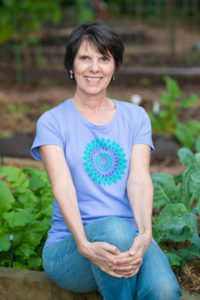Last Chance to Plant Cool Season Vegetables
Your February garden checklist should include your last opportunity to plant cool season vegetables. They need to have a chance to mature before the arrival of hot weather. It’s also a time for hard decisions. If we fill our garden beds with broccoli, lettuce and carrots this month, where will we put tomatoes, green beans and squash next month?
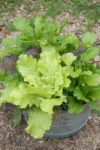
Grow cool weather greens in containers to save valuable space.
With the exception of quick-growing radishes and mesclun greens, the vegetables we plant in February will take 2-3 months to reach harvest size, taking up garden space until April or May. As tempting as it is to fill our gardens this month it would leave us with a dilemma in March – our prime time for planting warm season vegetables. A little planning and decision-making now on your February garden checklist will help keep the garden season moving along.
Create a Plan
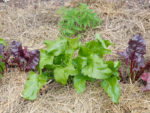
Beets growing at the edge of this bed will be harvested well before the tomato overtakes the space.
Make a list of what you want to plant, note the expected planting and harvest dates, and then look at your garden space and map out a planting plan. You may decide to forego that row of broccoli now in favor of green beans which can be planted in early March. Or perhaps you plant beets along the edge of a bed so you have room for tomatoes in the center, or grow lettuce and carrots in containers to free up valuable garden space for cucumbers.
Sketch it out on paper and pencil in what will go where with approximate planting dates. It’s a good feeling to have a plan in place and it’s a terrible feeling to realize that you don’t have room for a favorite tomato unless you pull up broccoli that is just starting to form a head.
February Garden Checklist
Here is the vegetable gardener’s checklist for February:
Fertilize
- Fertilize every 2-3 weeks with a liquid fertilizer or fish emulsion.
- If you are growing tomato transplants indoors be sure to fertilize them regularly to encourage strong, stocky growth and make sure they get plenty of light. If they have outgrown their pots move them up to a larger size.
Water
- Water plants during dry periods.
Plant
- Plant potatoes this month for harvest in late May or June. Cut seed potatoes into egg-sized pieces, making sure each piece has at least one eye. Dust the cut sections with sulfur or expose them to air for a few days to heal over before planting.
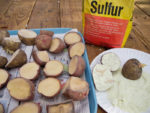
Dust potato pieces with sulfur before planting to help prevent disease.
Potatoes should be planted in a trench about 10-12 inches deep and one foot apart. Cover the potatoes with 3-4 inches of soil. As the stems emerge continue to cover with soil, leaving just the tips exposed. Potato tubers will form along the stems that are buried below the surface.
- Check the viability of older seeds before spring planting. To do this lay 10 seeds from the same packet on a moist paper towel and fold it over to cover the seeds. Place in a plastic bag, label with the date and place in a warm location. Check the seeds every few days until they have sprouted. If 8 to 10 seeds sprout then you can assume the seed from that packet has a good percentage of viability. If only 2 or 3 seeds sprout it may be time to buy new seeds.
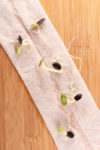
Sprout seeds in a moist paper towel to check for viability.
- Add some flowers and herbs in and around your garden. Now is a good time to plant alyssum, petunias, snapdragons, dianthus, calendula, dill, cilantro, thyme, borage, oregano and fennel.
- Plant basil seed indoors for transplanting after the weather is warm. There’s a basil for every palate, from classic Italian to spicy Thai to cinnamon scented basil with pretty lavender blooms.
Soil
- Take advantage of mild days to amend garden soil with 2-4 inches of compost in preparation for spring planting.
Maintenance
- Root crops – carrots, beets, radishes and turnips – should be thinned so plants are 3-4 inches apart. Overcrowding may prevent the roots from reaching their proper size.
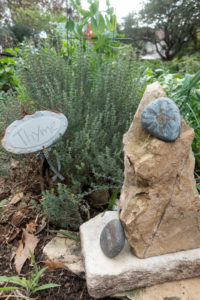
Plant herbs and flowers now to enjoy for months to come.
Additional Resources
Recommended Vegetable Varieties for Travis County
Sustainable Food Center Farmers Markets
Monthly Gardening Calendar for Austin and Central Texas
